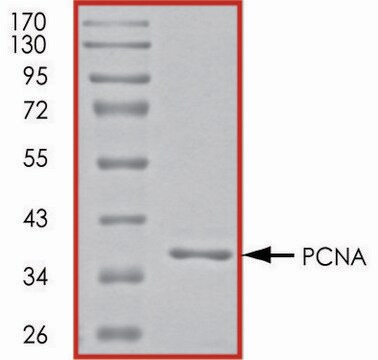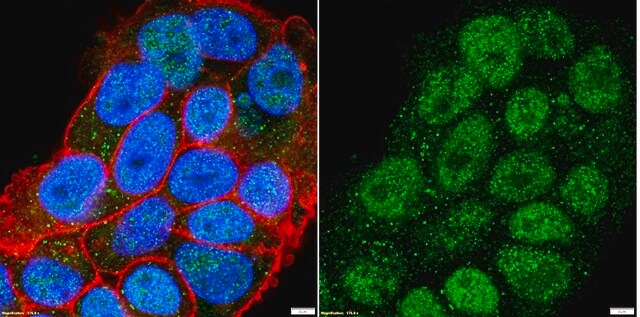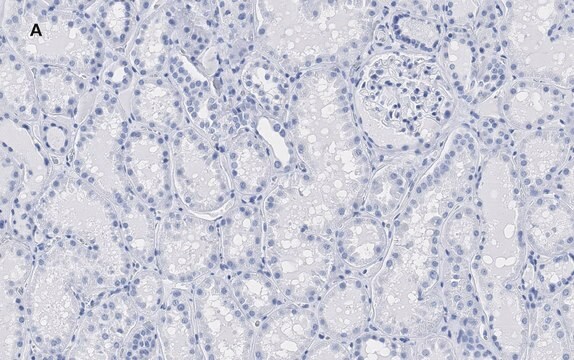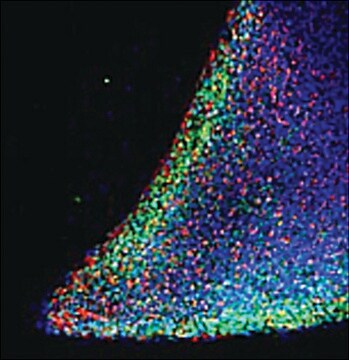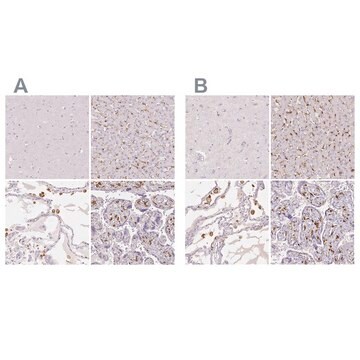推荐产品
生物源
human
重組細胞
expressed in E. coli
化驗
≥98% (HPLC)
≥98% (SDS-PAGE)
形狀
lyophilized
分子量
34.5 kDa
包裝
pkg of 20 μg
技術
cell culture | mammalian: suitable
雜質
<0.1 EU/μg endotoxin, tested
顏色
white to off-white
UniProt登錄號
運輸包裝
wet ice
儲存溫度
−20°C
基因資訊
human ... NANOG(79923)
一般說明
NANOG gene is localized to human chromosome 12p13.31 and has multiple pseudogenes. This gene is composed of four exons, three introns, and a 915bp open reading frame (ORF). The encoded protein was first discovered in ESCs (embryonic stem cells) and is a divergent homeobox domain protein. NANOG protein is composed of 305 amino acids and a central homeodomain (HD). This HD is composed of an unstructured N-terminal arm, a bundle of three α-helices (H1–H3) interlinked by loops.
Recombinant human Nanog is a 34.7kDa protein, which is synthesized as a 304 amino acid polypeptide lacking a signal sequence for secretion.
Recombinant human Nanog is a 34.7kDa protein, which is synthesized as a 304 amino acid polypeptide lacking a signal sequence for secretion.
生化/生理作用
NANOG is one of the central genes regulating self-renewal and pluripotency capacities of embryonic stem cells (ESC). Constitutive expression of this gene prevents the differentiation of ESCs, and along with SOX2 (SRY-box 4) and OCT-4 (octamer-binding transcription factor 4), it regulates pluripotency-related gene expression and maintains the pluripotency of ESCs. During ESC differentiation both these genes are down-regulated, and gene profiling shows that the expression of NANOG is uniformly high in ESC lines. There is significant similarity between ESC and carcinoma in situ testis (CIS), including the high expression of NANOG. It is novel marker for testicular CIS and germ cell tumors. NANOG shows abnormal expression in a variety of human cancers, such as carcinomas of the brain, oral cavity, head and neck, breast, lung, liver, pancreas, kidney, gastric, cervix, ovary, prostate, and colon. This expression is also related to treatment resistance and poor survival of cancer patients.
序列
SVDPACPQSL PCFEASDCKE SSPMPVICGP EENYPSLQMS SAEMPHTETV SPLPSSMDLL IQDSPDSSTS PKGKQPTSAE NSVAKKEDKV PVKKQKTRTV FSSTQLCVLN DRFQRQKYLS LQQMQELSNI LNLSYKQVKT WFQNQRMKSK RWQKNNWPKN SNGVTQKASA PTYPSLYSSY HQGCLVNPTG NLPMWSNQTW NNSTWSNQTQ NIQSWSNHSW NTQTWCTQSW NNQAWNSPFY NCGEESLQSC MQFQPNSPAS DLEAALEAAG EGLNVIQQTT RYFSTPQTMD LFLNYSMNMQ PEDV
外觀
Lyophilized with 10 mM Acetic Acid.
重構
Centrifuge the vial prior to opening. Reconstitute in water to a concentration of 0.1-1.0 mg/ml. Do not vortex. This solution can be stored at 2-8°C for up to 1 week. For extended storage, it is recommended to further dilute in a buffer containing a carrier protein (example 0.1% BSA) and store in working aliquots at -20°C to -80°C.
訊號詞
Warning
危險聲明
危險分類
Eye Irrit. 2 - Skin Irrit. 2
儲存類別代碼
11 - Combustible Solids
水污染物質分類(WGK)
WGK 3
閃點(°F)
Not applicable
閃點(°C)
Not applicable
Stem cell pluripotency factor NANOG is expressed in human fetal gonocytes, testicular carcinoma in situ and germ cell tumours.
Hoei-Hansen CE et al
Histopathology, 47(1), 48-56 (2005)
Shuai Gong et al.
Molecular carcinogenesis, 54(9), 679-687 (2015-05-28)
As one of the key pluripotency transcription factors, NANOG plays a critical role in maintaining the self-renewal and pluripotency in normal embryonic stem cells. Recent data indicate that NANOG is expressed in a variety of cancers and its expression correlates
Structure-based discovery of NANOG variant with enhanced properties to promote self-renewal and reprogramming of pluripotent stem cells.
Hayashi Y
Proceedings of the National Academy of Sciences of the USA, 112(15), 4666-4671 (2015)
Adam H Hart et al.
Developmental dynamics : an official publication of the American Association of Anatomists, 230(1), 187-198 (2004-04-27)
The murine Nanog gene, a member of the homeobox family of DNA binding transcription factors, has been shown recently to maintain pluripotency of embryonic stem cells. We have used a sequence homology and expression screen to identify and clone the
Kaoru Mitsui et al.
Cell, 113(5), 631-642 (2003-06-06)
Embryonic stem (ES) cells derived from the inner cell mass (ICM) of blastocysts grow infinitely while maintaining pluripotency. Leukemia inhibitory factor (LIF) can maintain self-renewal of mouse ES cells through activation of Stat3. However, LIF/Stat3 is dispensable for maintenance of
我们的科学家团队拥有各种研究领域经验,包括生命科学、材料科学、化学合成、色谱、分析及许多其他领域.
联系技术服务部门